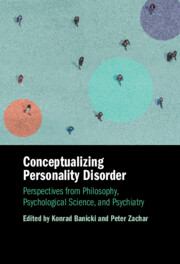 Conceptualizing Personality Disorder
Conceptualizing Personality Disorder Book contents
- Conceptualizing Personality Disorder
- Conceptualizing Personality Disorder
- Copyright page
- Contents
- Figures
- Tables
- Contributors
- Introduction
- Part I Historical Perspectives
- Part II Contemporary Approaches to Traditional Conceptual Perspectives
- Part III Novel Conceptual Approaches to Personality Disorder
- 10 What Does Personality Have to Do with Mental Disorder?
- 11 Self-Illness Ambiguity in Personality Disorders
- 12 On Personality Dimensions and Disorders
- 13 A Dual-Aspect Approach to Personality Disorder
- 14 Network Architectures of Personality and Its Pathology
- 15 From Paul Tillich’s The Courage to Be to Radical Acceptance and Radical Openness
- 16 Personality “Disorder” and the Incapacity to Self-Regulate
- Part IV Exploring Negative Consequences of Diagnosing Personality Disorder
- Part V Perspectives on Borderline and Narcissistic Personality
- Index
- References
12 - On Personality Dimensions and Disorders
Is a Trait-Based Approach Really the Answer?
from Part III - Novel Conceptual Approaches to Personality Disorder
Published online by Cambridge University Press: 25 June 2025
- Conceptualizing Personality Disorder
- Conceptualizing Personality Disorder
- Copyright page
- Contents
- Figures
- Tables
- Contributors
- Introduction
- Part I Historical Perspectives
- Part II Contemporary Approaches to Traditional Conceptual Perspectives
- Part III Novel Conceptual Approaches to Personality Disorder
- 10 What Does Personality Have to Do with Mental Disorder?
- 11 Self-Illness Ambiguity in Personality Disorders
- 12 On Personality Dimensions and Disorders
- 13 A Dual-Aspect Approach to Personality Disorder
- 14 Network Architectures of Personality and Its Pathology
- 15 From Paul Tillich’s The Courage to Be to Radical Acceptance and Radical Openness
- 16 Personality “Disorder” and the Incapacity to Self-Regulate
- Part IV Exploring Negative Consequences of Diagnosing Personality Disorder
- Part V Perspectives on Borderline and Narcissistic Personality
- Index
- References
Summary
There is general agreement that the categorical approach to personality disorders is flawed, and many propose that the Five Factor Model (FFM) provides a sound alternative dimensional model of normal personality that can be applied to helping understand personality pathology. There are, however, logical concerns as to whether trait-based approaches can provide a coherent theoretical framework for comprehending personality pathology. This chapter evaluates the theoretical soundness of the FFM trait approach as a basis for comprehending personality pathology. The chapter first examines the conceptual standing of traits in relation to the generally under-appreciated conceptual distinction between nonrelational properties and relations. The theoretical problems of reification and circular explanation are then used to demonstrate that although traits might help discern individual differences within the population, they are logically precluded from explaining personality pathology. An alternative theoretical approach for understanding personality is proposed based on integrating motivational, cognitive, and affective processes and recognizing the importance of philosophical enquiry for identifying logical commitments that any theory of personality must satisfy. This chapter further highlights the necessity for rigorous theoretical research in scientific psychology to effectively address personality pathology.
Information
- Type
- Chapter
- Information
- Conceptualizing Personality DisorderPerspectives from Philosophy, Psychological Science, and Psychiatry, pp. 215 - 233Publisher: Cambridge University PressPrint publication year: 2025